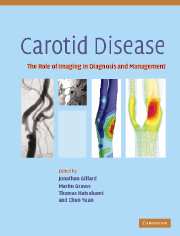Book contents
- Frontmatter
- Contents
- List of contributors
- List of abbreviations
- Introduction
- Background
- Luminal imaging techniques
- Morphological plaque imaging
- Functional plaque imaging
- Plaque modelling
- Monitoring the local and distal effects of carotid interventions
- 25 Transcranial Doppler monitoring
- 26 Imaging carotid disease: MR and CT perfusion
- 27 Near infrared spectroscopy in carotid endarterectomy
- 28 Single photon emission computed tomography (SPECT)
- 29 Monitoring carotid interventions with xenon CT
- Monitoring pharmaceutical interventions
- Future directions in carotid plaque imaging
- Index
- References
27 - Near infrared spectroscopy in carotid endarterectomy
from Monitoring the local and distal effects of carotid interventions
Published online by Cambridge University Press: 03 December 2009
- Frontmatter
- Contents
- List of contributors
- List of abbreviations
- Introduction
- Background
- Luminal imaging techniques
- Morphological plaque imaging
- Functional plaque imaging
- Plaque modelling
- Monitoring the local and distal effects of carotid interventions
- 25 Transcranial Doppler monitoring
- 26 Imaging carotid disease: MR and CT perfusion
- 27 Near infrared spectroscopy in carotid endarterectomy
- 28 Single photon emission computed tomography (SPECT)
- 29 Monitoring carotid interventions with xenon CT
- Monitoring pharmaceutical interventions
- Future directions in carotid plaque imaging
- Index
- References
Summary
Introduction
The use of in vivo tissue near infrared spectroscopy (NIRS) in humans was first described more than 25 years ago by F. F. Jöbsis (Jöbsis, 1977). The technique is based on the concept that light of wavelengths 680–1000 nm is able to penetrate human tissue and is absorbed by the chromophores oxyhemoglobin (HbO2), deoxyhemoglobin (Hb) and cytochrome oxidase. Changes in the detected light levels can therefore represent changes in concentrations of these chromophores. The noninvasive nature of the technique led to its first clinical application for monitoring the cerebral oxygenation status of premature infants (Brazy et al., 1985). Since then it has become an established research tool with numerous applications (Ferrari et al., 1986; Brown et al., 1993; Aldrich et al., 1994; Villringer et al., 1994; Lam et al., 1996; Elwell et al., 1997; Tamura et al., 1997; Nollert et al., 2000; Watanabe et al., 2002; Vernieri et al., 2004).
Whilst its clinical use for monitoring the brain has been well established in neonates, where transillumination is possible due to the thin skull and small dimensions, clinical application of NIRS for monitoring the adult brain has been hampered by the fact that it must be applied in reflectance mode (Young et al., 2000).
- Type
- Chapter
- Information
- Carotid DiseaseThe Role of Imaging in Diagnosis and Management, pp. 372 - 386Publisher: Cambridge University PressPrint publication year: 2006



